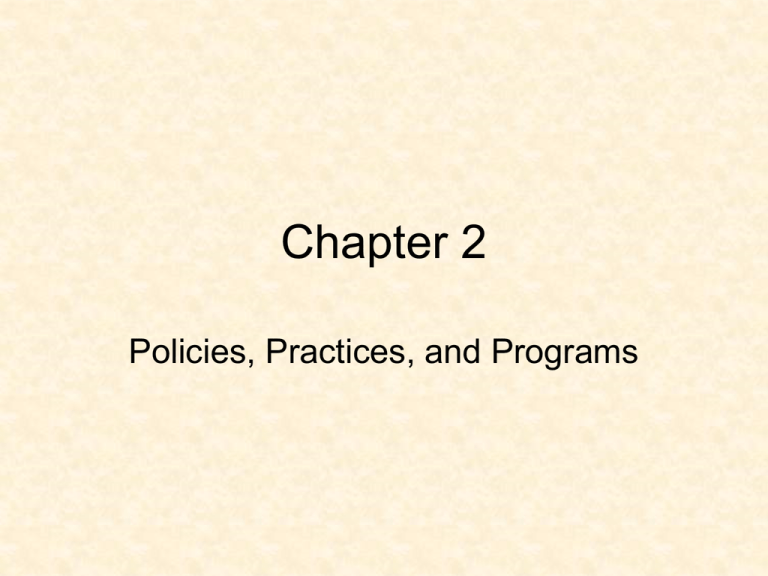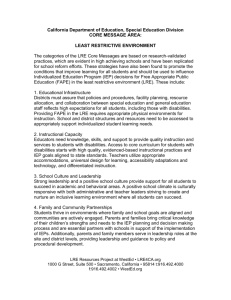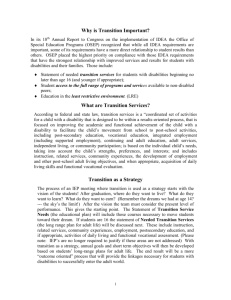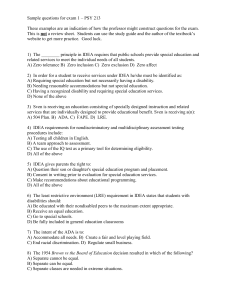Chapter 2
advertisement

Chapter 2 Policies, Practices, and Programs Disability Litigation Begins Case Brown v. Board of Education Diana v. State Board of Education PARC Date Importance 1954 no segregation by race - cannot be excluded from school class placement – students tested in primary language Guaranteed special education for children with mental retardation 1970 1972 Mills v. Board of Education 1972 Extended the right to special education to children of all disabilities Larry P. v. Riles 1972 Tests used for eligibility for special education must be non-discriminatory; class placement parallel to “Diana” for African American – only in Ca. The Education for All Handicapped Children Act (PL 94-142) • President Gerald Ford, 11/29/1975 • “ Bill of Rights” for children with exceptionalities • Six major components • Preschool Incentive Grants • Evaluation of children from birth to age 21 • Exact count of children served PL 94-142 & the Big Six • • • • • • Free and appropriate public education Least restrictive environment Individualized education program Procedural due process Nondiscriminatory assessment Parental participation LRE • Least Restrictive Environment – Education of children with disabilities to the maximum extent possible with students without disabilities – Placement must be consistent with educational needs IEP • Individualized Education Plan – Individually tailored educational plan developed in conjunction with the parents or guardians • • • • • • Present level of performance Annual goals Instructional objectives Degree of participation in general education Dates of initiation of services Annual evaluation FAPE • Free and Appropriate Public Education – Zero reject policy – Education according to unique needs – No cost to parent or guardian – Concept of related services in order to benefit from special education Designing the IEP • • • • Present levels of performance Statement of annual goals & measurement Short term instructional objectives Related services, program modifications, supports, explanation of LRE choice • State/district wide assessment status • Service: initiation, duration, location, frequency • Transition Individualized Family Service Plan (IFSP) • Statement of infant or toddler’s – Physical, cognitive, communication, social/emotional/ and adaptive development levels – Major outcomes expected to be achieved – Specific early intervention services, their environment, and timelines – Name of service coordinator, initiation and duration of services, transitioning elements DUE PROCESS • Procedural Due Process – Parent/guardian safeguards and rights • • • • Confidentiality Examination of all records To obtain an independent evaluation Notification of proposed changes to the IEP or placement must be in writing • Pertinent correspondence in parent’s native language • Impartial hearing and representation by legal counsel NON DISCRIMININATORY ASSESSMENT • Evaluation – By a multidisciplinary team – In all areas of suspected disability – With tests that are neither culturally, linguistically, or racially biased – Administered by trained personnel – Must be based on several types of assessment PARENTAL PARTICIPATION • Parent’s Law – Meaningful parental involvement – Full participation in the decision-making process that affects their child’s education 1986 Amendments to PL 94-142 (PL 99-457) • All preschoolers with special needs ages 3 through 5 are to receive a free and appropriate public education • Title 1- Handicapped Infants and Toddlers Program established for children from birth through 2 with developmental delays or disabilities 1990 Amendments to PL 94-142 PL 101-476 • Individuals with Disabilities Education Act (IDEA) – Individual transition plans (ITP) – Expanded related services– social work and rehabilitation counseling – Distinct disability categories for autism and traumatic brain injury – Allows parents and others to sue the state in federal court for noncompliance with law 1997 Amendments to IDEA PL 105-17 • • • • Disciplinary removal for 45 days Manifestation determinations Justification for exclusionary placements Orientation and mobility for students with vision impairments • Developmental delays • Services excludes delays contributed to lack of education opportunity or limited English proficiency • Mandatory academic performance assessment American with Disabilities Act PL 101-336 • Civil rights legislation for individuals with disabilities- signed into law July 26, 1990 by President George Bush – Clear, strong, enforceable standards for prohibiting discrimination (Turnbull, 1993) – Forbids discrimination in public and private sectors Section 504 of the Rehabilitation Act of 1973 • A civil rights law that protects children and adults with disabilities against intentional or unintentional discrimination • Reasonable accommodations to participate in educational programs provided to other students • Applies to all educational agencies that receive federal funding ADA • Examples of ADA Influence –areas of accommodation –access to private and public buildings –hiring practices, promotion decisions –mass transit accessibility –telecommunication ADA and Education • Reasonable accommodation for students with disabilities – Accessibility- ramps, elevators, building modifications – Modification of examinations, training materials, and policies – Provision of qualified readers, interpreters – Modifying the work schedule IDEA, Section 504, and ADA IDEA (2-21) Section 504 (lifespan) ADA (lifespan) Children and Adults No Child Left Behind Act of 2001 PL 107-110 • Reauthorization of the Elementary and Secondary Education Act – All pupils will demonstrate proficiency in mathematics and reading – Annual testing will show adequate yearly progress (AYP) – Consequences for lack of AYP= parent may transfer their child to another school – Highly qualified teachers and aides Professionals in Special Education • Special education teachers – Itinerant special educator – Bilingual special educator – Early childhood special educator • • • • • Speech/language therapist School psychologist School counselor School nurse Educational interpreter Others in Special Education • • • • General education teacher Paraeducators Parents Other highly specialized service providers – – – – Adaptive physical educator Orientation and mobility specialist Physical or occupational therapist Audiologist Eligibility for Special Education Referral and Assessment for Special Education • • • • Pre-referral Referral Assessment Instructional Programming and Appropriate Placement – Individualized Education Program (IEP) – Individualized Family Service Plan ( IFSP) Pre-referral • Intervention strategy • Occurs prior to initiating a referral for possible special education services – Reduces unwarranted referrals – Provides individualized service – Collaboration between general educators and other professionals • Shared responsibility for child’s success Referral • Written request to evaluate a student to determine whether or not the child has a disability – Arises from concern over child’s academic achievement or social/behavioral problems – 75% of the referrals for special education service actually result in placement; the remaining children are found ineligible Assessment Components • Student must be assessed in all areas of suspected need • Assessment typically includes: – – – – – – Vision and hearing screening Intelligence testing Achievement testing Social and behavioral functioning Developmental history Other areas needed Norm-Referenced Test • Standardized Tests • Compare pupil’s performance with that of a representative sample of children • Data– percentile ranks, stanines, or grade equivalent scores • Provide limited instructional information Criterion-Referenced Test • Student’s performance on a task is compared to a particular level of mastery • Criterion level established by teacher • Data is useful for instructional planning • Determines individual skill mastery and patterns of strength Assessment Procedures • Must be nondiscriminatory on a racial or cultural basis • Instruments must be valid and reliable • Instruments must be administered by trained professionals • Testing must be in the language or form most likely to provide accurate information on the child’s abilities • Include a variety of assessment tools Decision-Making for Special Education • Does student have a disability? • Does the disability adversely affect educational performance? • Is the student eligible for special education and related services? Service Delivery Options • Least Intense, Most Integrated – – – – – – – Regular classroom with modification/support Regular classroom /resource room Part time regular classroom Full time special class Special day school/Residential School Homebound instruction Hospital and treatment centers • Most Intense, Least Integrated ↓ Mainstreaming • Social and instructional integration • Places students with disabilities into educational programs whose primary purpose is to serve typically developing individuals • Must provide an appropriate education based on unique needs Least Restrictive Environment • The desire to provide an LRE must be balanced by the requirement of providing an education appropriate to the unique needs of the individual • The integrative environment may not always be the most appropriate placement option Regular Education Initiative (REI) • Madeline Will, 1986, Former Assistant Secretary of Education (Office of Special Education and Rehabilitative Services) – Envisioned a cooperative system that would “bring the program to the child, not the child to the program" (Will, 1986a, p.21) – Programs would encompass greater cooperation, collaboration, coordination between general and special educators Full Inclusion • A belief that all children with disabilities should be taught exclusively – with appropriate supports – in general education classrooms • age/grade appropriate • at neighborhood schools • where they would attend if they were not disabled Inclusion Positions • Con: The neighborhood general education classroom is not preferable to a cascade of services • Pro: Full inclusion combined with a collaborative partnership between special and general education would result in a better education for all pupils, not just those with special needs What Is Full Inclusion? • Attending your home school • Natural proportion of children with special needs at the school site and in your classroom • Placement with students at your appropriate grade level and chronological age • Where educational services are provided not what is taught or the kinds of services offered







